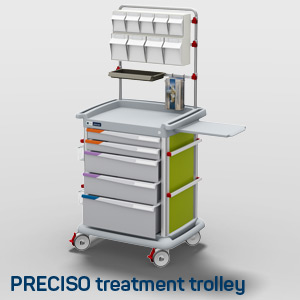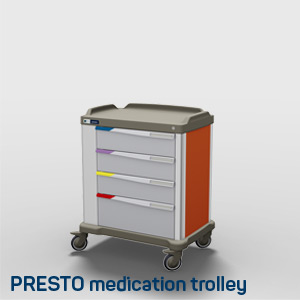QUICK LINKS:
PRECISO line of trolleys
PRESTO line of trolleys
ESSENTIAL line of trolleys
PERSOCAR Inox line of trolleys
Vaccination trolley
Interested in FH’s newsletter? Click here to subscibe and receive news on our world: interesting features and details of our products, tips and much more.
What is a ward trolley?
Each hospital ward has its own distinctive traits: type, average patient stay, gender (male or female) and age (e.g. paediatric wards), number of nurses and number of beds, type of drugs and devices typically used, … and much more.
Each ward, therefore, requires specific organisation and logistics for the handling of materials: from storage and transport to distribution to the point of use.
Materials can be very heterogeneous: drugs, medical and non-medical devices, clean and dirty linen, general waste and potentially infected waste, …
The means of handling and distribution must adapt to the environment and the material.
Is it better to have a small ward trolley with lots of small drawers, or one small drawer and three larger ones?
How many large drawers for IV bottles? Do you need a catheter holder? Do you need a bottle holder?
Do you need an overbridge for adding accessories? How should the trolley be equipped? 1 glove box holder or 3, for different sizes?
These and other needs must be addressed, and each answer contributes to the design and size of the trolley to be used in that specific ward, hospital or nursing home.
There are as many answers as there are wards, and teams of professionals working in them.
And then there is the emergency trolley, a real mobile first aid station. And also the Broselow-coded paediatric emergency trolley, which must have at least 8 differently colour-coded drawers.
There’s the patient-round trolley, with large drawers for medical records, or maybe with an onboard PC, be it a laptop or AIO (all-in-one).
Or the anaesthesia trolley: with well-organised drawers for various medications and perhaps controlled access.
There is also the vaccination trolley (very relevant, now that COVID-19 vaccinations are being carried out) or the plaster trolley, with all stainless steel surfaces and the possibility of fitting a water basin.
Then there are trolleys for patient and bedside hygiene: they must be able to hold towels, cleaning fluids, clean gowns or the patient’s personal change, clean bed linen.
There are also newly developed therapy trolleys. The oncology centre in Toulouse, France, has recently introduced a ‘sensory trolley’: it has softly coloured walls and is equipped with an IV pole and a video projector: it is brought into the patient’s room for relaxation sessions during the administration of infusion therapy.
It is difficult to describe in a few words the complexity and variety of hospital wards. The more flexible and modular the solution, the easier and more feasible it is to provide a timely and efficient response, which helps operators in their daily work, thanks also to customisation with a variety of accessories, with drawers in various sizes, even transparent and transportable, with ergonomic accessories and solutions that can be scaled up to meet changing needs.
Customisation is one of FH’s main objectives. All products are designed and engineered right from the start to address individual realities and requirements.


